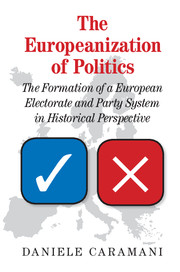 The Europeanization of Politics
The Europeanization of Politics Book contents
- Frontmatter
- Contents
- List of Figures
- List of Tables
- Preface and Acknowledgements
- List of Abbreviations
- Introduction: Electoral Integration in Europe
- Part I Framework
- Part II Analysis
- 3 Homogeneity: Convergence and Deviation in European Electoral Development, 1848–2012
- 4 Uniformity: Electoral Waves and Electoral Swings across Europe, 1848–2012
- 5 Correspondence: Overlapping versus Distinctive Electorates in National and European Elections, 1974–2012
- 6 Cohesion: Ideological Convergence within European Party Families, 1945–2009
- 7 Closure: The Europeanization of Cabinet and Coalition Politics, 1945–2009
- Part III Assessment
- Conclusion: Towards Europe-wide Representation
- Appendices
- References
- Index
4 - Uniformity: Electoral Waves and Electoral Swings across Europe, 1848–2012
from Part II - Analysis
Published online by Cambridge University Press: 05 November 2015
- Frontmatter
- Contents
- List of Figures
- List of Tables
- Preface and Acknowledgements
- List of Abbreviations
- Introduction: Electoral Integration in Europe
- Part I Framework
- Part II Analysis
- 3 Homogeneity: Convergence and Deviation in European Electoral Development, 1848–2012
- 4 Uniformity: Electoral Waves and Electoral Swings across Europe, 1848–2012
- 5 Correspondence: Overlapping versus Distinctive Electorates in National and European Elections, 1974–2012
- 6 Cohesion: Ideological Convergence within European Party Families, 1945–2009
- 7 Closure: The Europeanization of Cabinet and Coalition Politics, 1945–2009
- Part III Assessment
- Conclusion: Towards Europe-wide Representation
- Appendices
- References
- Index
Summary
Introduction
Since the first pioneering electoral analyses carried out in the United States and Europe at the beginning of the 20th century, the commonality and simultaneity of electoral change has been considered an important indicator of the degree to which a political system is integrated. Common shifts of votes occurring between elections in all territorial areas of a political system mean that the system's parts move together and that everywhere its electorates respond similarly to common factors and issues. Such general simultaneous change of votes towards or away from party families points to an advanced degree of integration of political systems. This classical indicator of vote shifts allows assessing the presence of “waves” or “tides” of electoral change across Europe.
While in the past uniform change has been investigated across constituencies at the national level, this chapter uses this conceptual tool to analyze the formation of a Europe-wide electorate. The detection of waves can be interpreted as an indicator of a “Europeanized” electorate that refers to common supra-national issues, is affected by similar vote determinants, or undergoes similar structural change. When used at the level of national electorates and party systems, shifts of votes are considered an important indicator of the degree of “nationalization” of electoral politics. This chapter extends the use of this indicator to assess the degree of “Europeanization” of electoral politics. Insofar as one can detect common waves of change that take place simultaneously everywhere in Europe – or, at least, in most European political systems – we can speak of a Europeanized or integrated dimension of electoral politics.
To what extent is – in a long-term perspective – electoral change common and simultaneous in Europe? To what extent do national electorates move together in waves of change over the past century and a half? What are the most important waves in the past and how do recent waves compare to those fundamental transformations? Are the waves of the past mostly along the left–right axis while since the de- and re-alignment in the 1970s such waves take place along other dimensions of contestation?
- Type
- Chapter
- Information
- The Europeanization of PoliticsThe Formation of a European Electorate and Party System in Historical Perspective, pp. 118 - 148Publisher: Cambridge University PressPrint publication year: 2015


